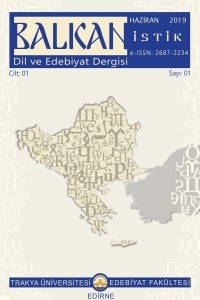HATA ANALİZİ: TÜRKÇEDE İSMİN HÂLLERİ VE TÜRKÇE ÖĞRENEN ÖĞRENCİLERİN BU KONUDA YAPTIĞI HATALAR
Hedef dili öğrenirken hata kavramı yanlış anlaşılmaktadır. Hata, yabancı bir dil öğrenme sürecine yardımcı olabilir, hem öğrenciye hem de öğretmene geri bildirim verebilir. Bu amaçla “Hata Analizi“ yöntemi geliştirilmiştir. Hata Analizi hem karmaşık hem de zaman alıcı bir süreçtir, ancak eğitim sürecinde büyük ölçüde yardımcı olur. Genellikle bu amaç için özel olarak hazırlanmış bir sınavın/testin tamamlanması ile yapılır. Testi tamamladıktan sonra, oldukça yüksek bir frekansta ve kapsamda bulunan hatalar tespit edilir. Daha sonra, aynı anda dil içi ve diller arası hatalar olarak kategorize edilerek hata, haklı çıkarılmaya çalışılır. Bu makalede, Türkçenin durum/hâl sistemi ve bu durumların/hâllerin ana dili Yunanca olan kişiler tarafından anlaşılması ile ilgili olarak yukarıdaki prosedür izlenmiştir. Bu yöntemin, Türkçenin bu gramer konusunda kullanılması da ilginçtir çünkü Yunancada Türkçe gibi beş durum/hâl yoktur. Bu nedenle, Yunancadaki düşünme biçimi ve Türkçe konuşma çabası, hatanın daha fazla gerekçelendirilmesi için dilsel önemi olan bazı hatalar göstermiştir.
Anahtar Kelimeler:
Hata Analizi, Yunanca-Türkçe, Durum/Hâl Sistemi, Dil İçi Hata, Diller Arası Hata
ERROR ANALYSIS: THE CASE SYSTEM OF TURKISH AND THE MISTAKES OF GREEK-SPEAKING STUDENTS
During the learning of the target language, the concept of error is misunderstood. The mistake can help the process of learning a foreign language, giving feedback to both student and teacher. For this purpose, the method “Error Analysis” was developed. Error Analysis is both a complex and time-consuming process, which, however, helps tremendously in the educational process. It is usually done by completing an exam/test that has been specially prepared for this purpose. After completing the test, those errors that have been found in a fairly high frequency and extent are identified. Then, an attempt is made to justify the error by simultaneously categorizing into intralingual and interlingual errors. In this article, the above procedure has been followed regarding the case system of Turkish and the understanding of these cases by native Greek language learners. The use of this method in this grammatical subject of Turkish is interesting, as Greek language does not have five cases like Turkish. Thus, the way of thinking in Greek and the attempt to produce speech in Turkish have shown some errors which have linguistic significance for further justification of the error.
Keywords:
Error Analysis, Greek-Turkish, Case System, Intralingual Error, Interlingual Error,
___
- BROWN, H. Douglas (1980), Principles of Language Learning and Teaching, 4th Edition, Harlow: Longman.
- CHOMSKY, Noam (2007), Gia tin Fisi kai Tin Glossa (Για τη φύση και τη γλώσσα), G. Kotzoglou. (Trans.), Athens: Ekdoseis Dim. N. Papadima.
- CORDER, Stephen Pit (1974), “Error Analysis”, The Edinburgh Course in Applied, Linguistics Vol. 3, J. P. B. Allen, Stephen Pit Corder (Ed.), London: Oxford University Press.
- CRYSTAL, David (2006), Lexiko Glossologias kai Fonologias (Λεξικό Γλωσσολογίας και Φωνολογίας), Ksidopoulos G. (Trans.), Athens: Ekdoseis Pataki.
- ELLIS, Rod (1994), The Study of Second Language Acquisition, Oxford: Oxford University Press.
- GÖKSEL, Aslı, KERSLAKE, Celia (2006), Turkish A Comprehensive Grammar, New York: Routledge.
- KETREZ, F. Nihan (2012), A Student Grammar of Turkish, Cambridge: University Press of Cambridge.
- RICHARDS, Jack C. (1980), “Second Language Acquisition: Error Analysis”, Annual Review of Applied Linguistics, 1, 91-107.
- SAVILLE-TROIKE, Muriel (2006), Introducing Second Language Acquisition, New York: Oxford University Press.
- SCHUMANN, John H. (1975), “Affective Factors and the Problem of Age in Second Language Acquisition”, Language Learning, 25(2), 209–235.
- SELINKER, Larry (1972), “Interlanguage”, International Review of Applied Linguistics in Language Teaching, 10, 209-231.
- SELLA-MAZI, Eleni (2004), Stoixia Antiparavolikis Grammatikis Ellinikis-Tourkikis (Στοιχεία Αντιπαραβολικής Γραμματικής Ελληνικής-Τουρκικής), Athens: Papazisi.
- TRIARHI–HERMANN, B. (2000), I diglossia stin Paidiki Ilikia – Mia Psichologiki Proseggisi (Η διγλωσσία στην Παιδική Ηλικία – Μία ψυχολογική προσέγγιση), Athens: Gutenberg.
- van ELS, Theo, BONGAERTS, Theo, EXTRA, Guus, van OS, Charles, JANSSEN-van DIETEN Anne-Mieke, (1984), Applied Linguistics and the Learning and Teaching of Foreign Languages, London: Edward Arnold.
- WIDDOWSON, Henry G. (1978), “The Significance of Simplification”, Studies in Second Language Acquisition, 1 (1), 11-20.
- Yayın Aralığı: Yılda 2 Sayı
- Başlangıç: 2019
- Yayıncı: Trakya Üniversitesi
Sayıdaki Diğer Makaleler
ÇAĞDAŞ YUNAN EDEBİYATINDA POLİSİYE TÜRDEKİ İLK ÖRNEKLERİN KISA BİR TARİHİ
BULGAR EDEBİYATINDAKİ İLK İSTANBUL SEYAHATNAMESİ ÜZERİNE BAZI GÖZLEMLER
TRAJİĞİN İRONİSİ: ÖLÜ ORDUNUN GENERALİ ÜZERİNE
17. YÜZYILA AİT ANONİM BİR TÜRKÇE-SIRPÇA HIRVATÇA SÖZLÜK
HATA ANALİZİ: TÜRKÇEDE İSMİN HÂLLERİ VE TÜRKÇE ÖĞRENEN ÖĞRENCİLERİN BU KONUDA YAPTIĞI HATALAR
